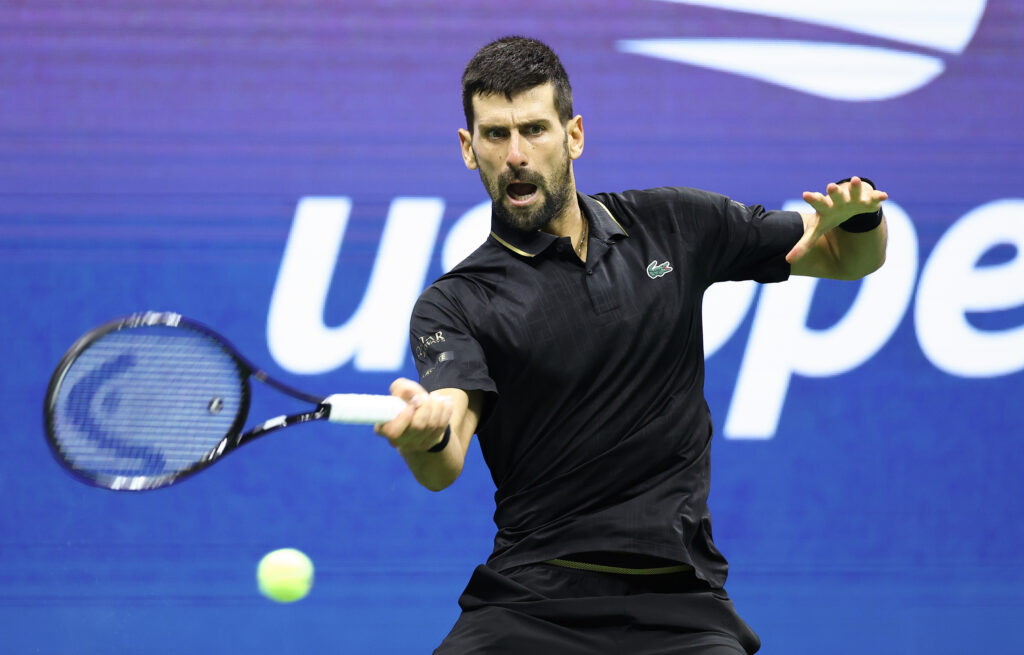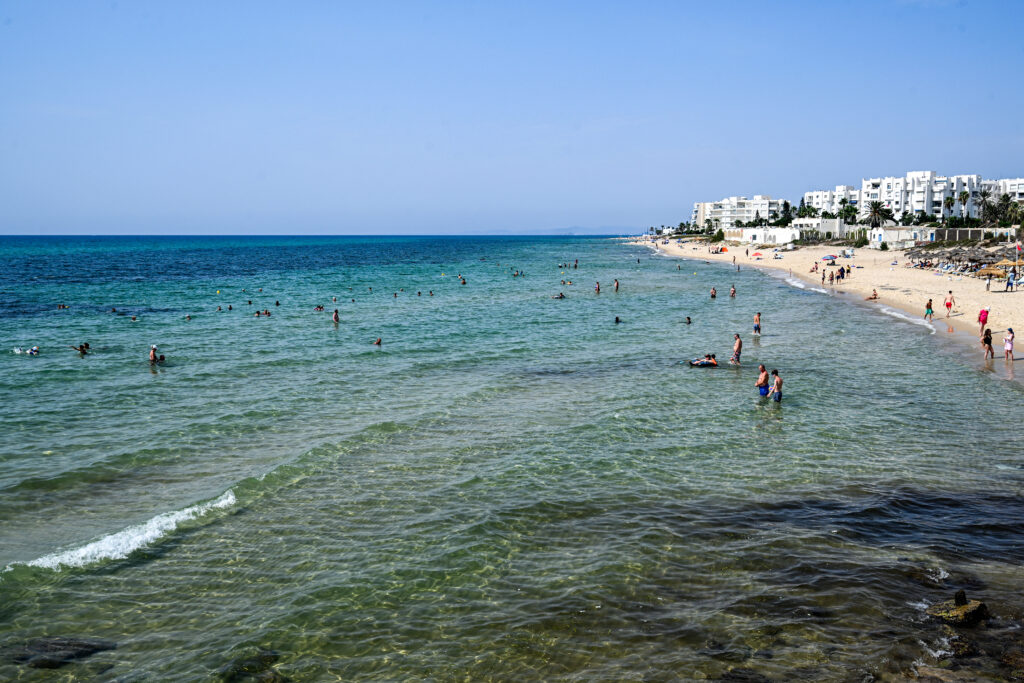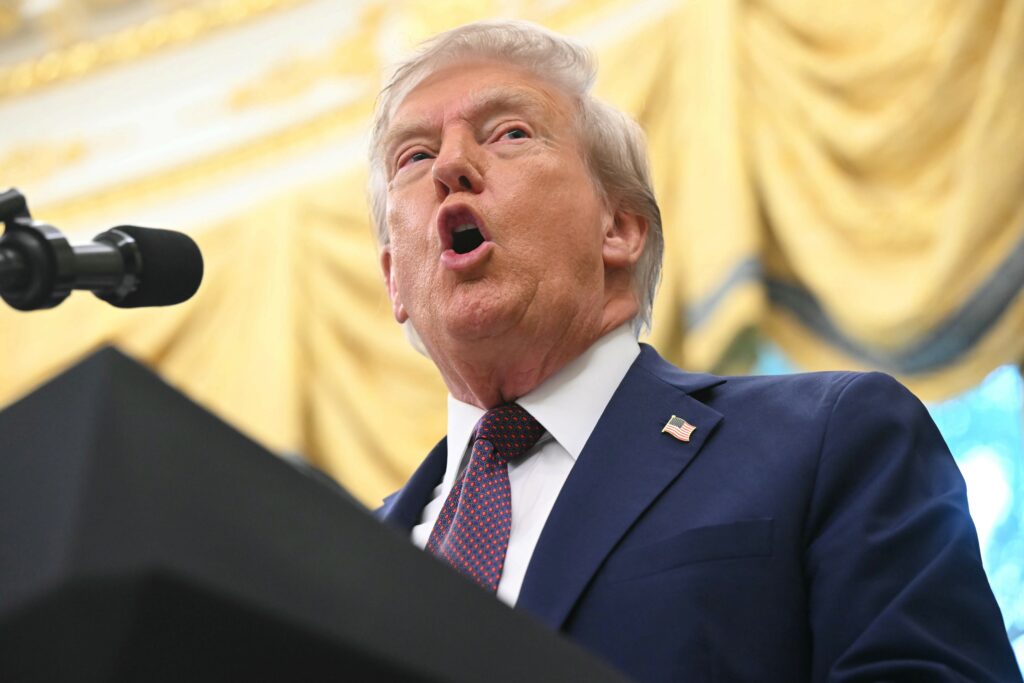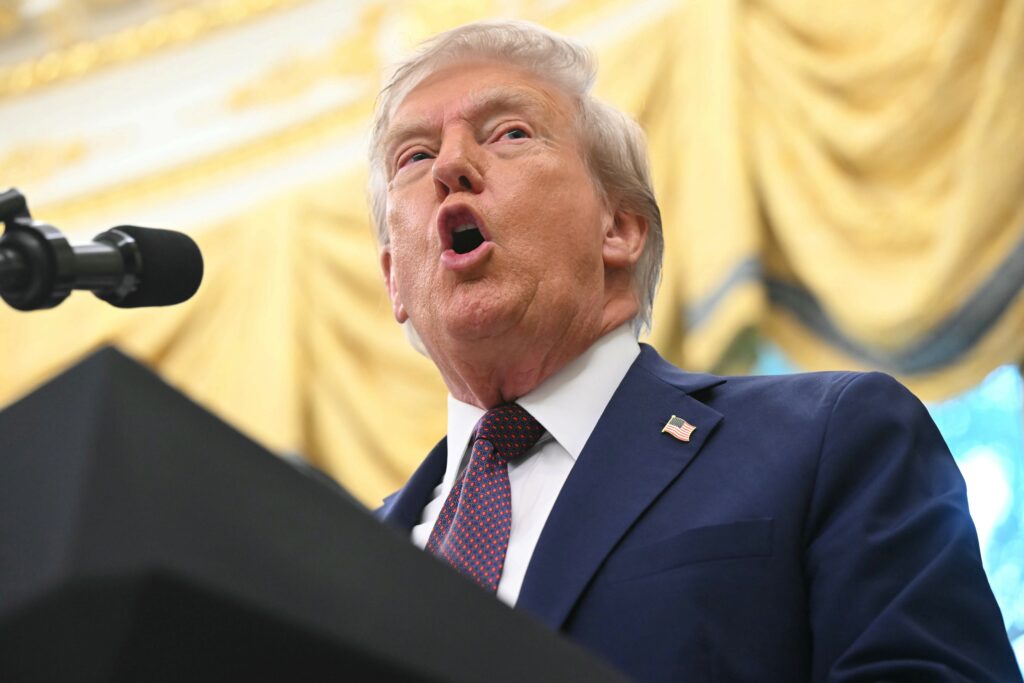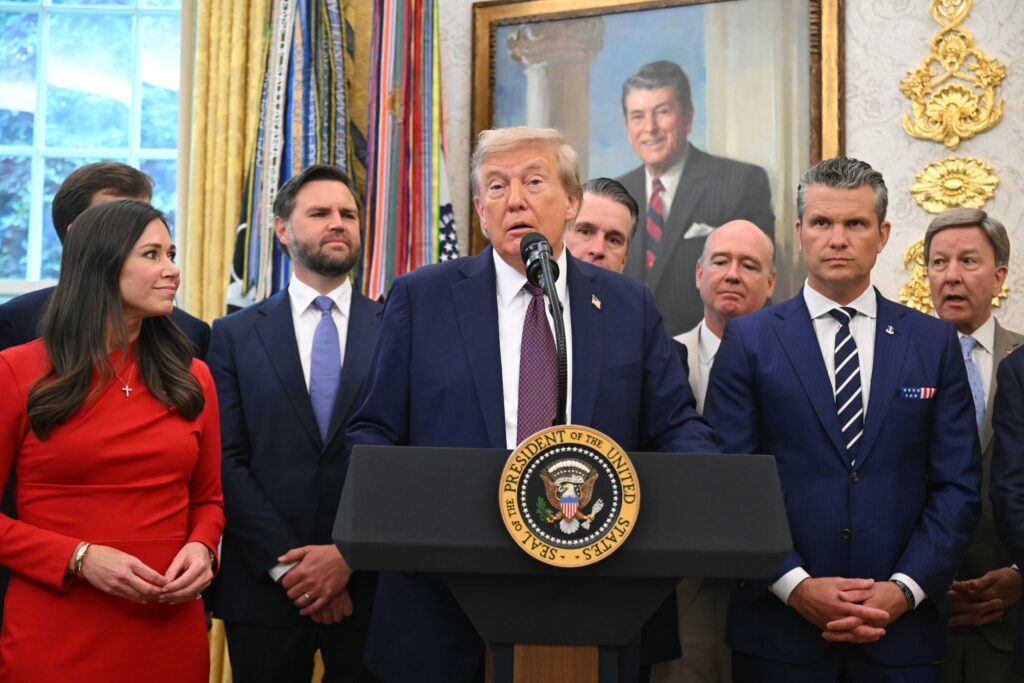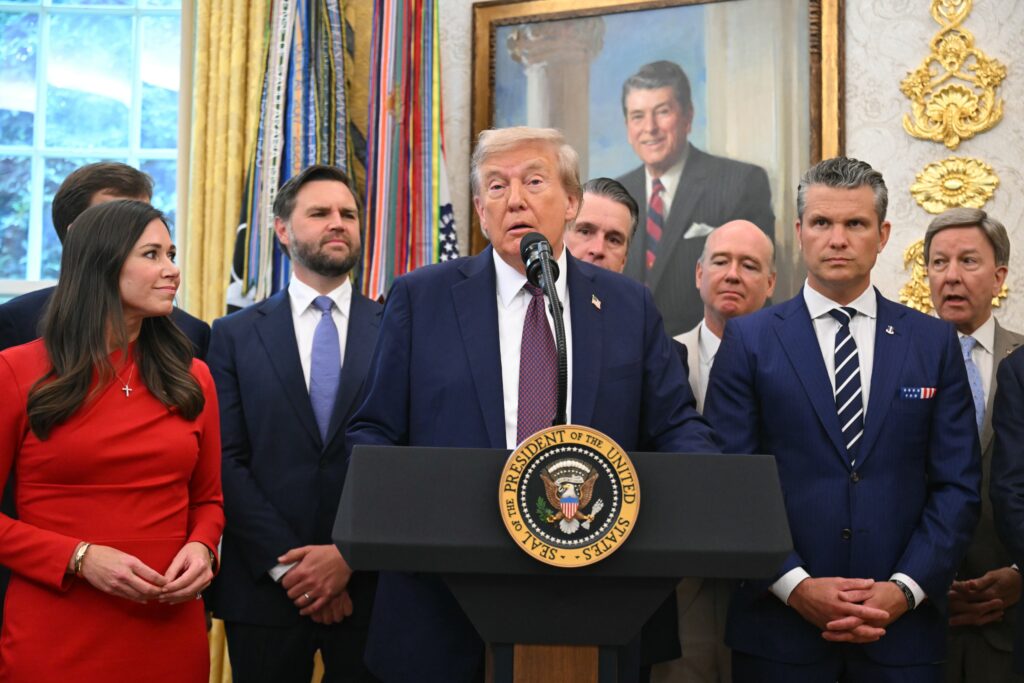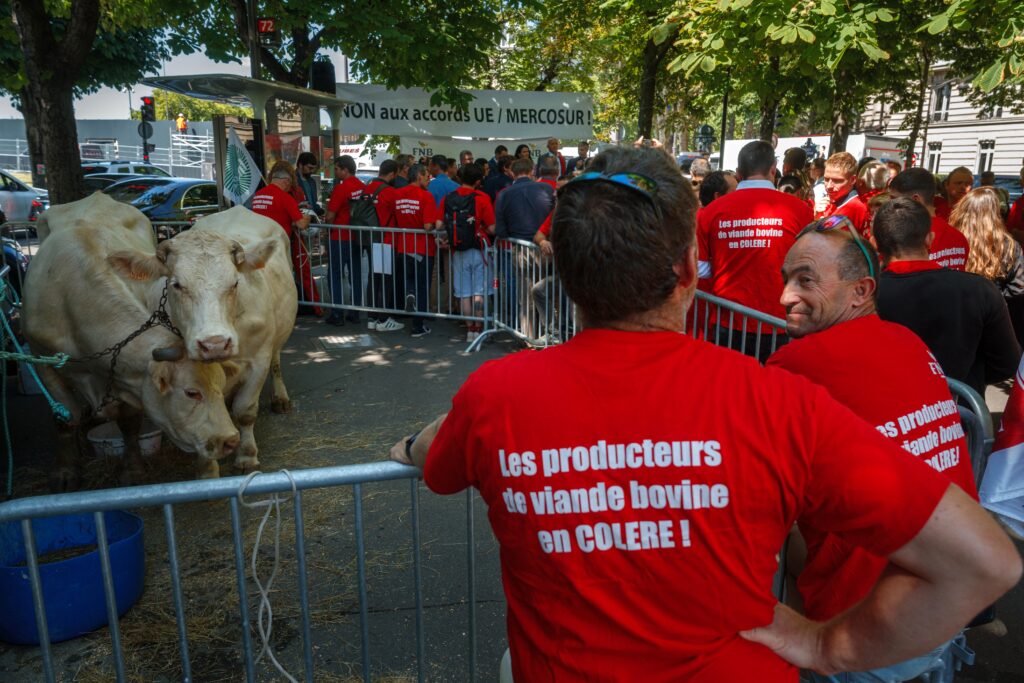US Open: choc Djokovic-Alcaraz en demi-finale, Sabalenka qualifiée sur forfait
En gémissant puis en dansant, Novak Djokovic a rejoint mardi Carlos Alcaraz en demi-finales de l’US Open, la N.1 mondiale Aryna Sabalenka se qualifiant elle sans jouer pour le dernier carré, où elle retrouvera Jessica Pegula, sa victime en finale de l’édition 2024.- Djokovic serre les dents -Malmené physiquement par le finaliste sortant à New York Taylor Fritz (4e au classement ATP), Novak Djokovic s’est montré plus réaliste que l’Américain pour s’imposer en quatre sets mardi en quarts de finale: 6-3, 7-5, 3-6, 6-4. Il a célébré sa victoire en esquissant quelques pas de danse pour sa fille, qui vient de fêter son anniversaire et dont il a raté l’anniversaire puisqu’il est toujours en lice à New York.”C’était un match incroyablement serré, j’ai eu de la chance d’écarter plusieurs balles de break à des moments importants dans le deuxième set”, a soufflé le vainqueur dans son interview d’après-match.”Durant l’essentiel des deuxième et troisième sets, il (Fritz, NDLR) était le meilleur joueur sur le court. Je n’ai pas senti que je dominais depuis le fond de court”, a ajouté un Djokovic soulagé d’avoir maintenu en vie son rêve d’un 25e titre record en Grand Chelem.Il retrouvera dans le dernier carré le N.2 mondial Carlos Alcaraz, qu’il avait dominé en quarts de finale de l’Open d’Australie en janvier lors de leur dernière confrontation.Eliminé l’an dernier au deuxième tour, l’Espagnol est revenu à New York le couteau entre les dents et s’est imposé mardi 6-4, 6-2, 6-4 contre le Tchèque Jiri Lehecka (21e).Souvent dépeint comme un joueur inconstant, coupable de relâchements soudains en plein match, Alcaraz a tenu la barre trois sets durant, comme aux tours précédents, et n’a concédé aucune balle de break.”Aujourd’hui, j’ai eu droit à la version Grand Chelem de Carlos”, a résumé Lehecka. “Ce n’est même pas que j’ai fait un mauvais match, (…) il avait réponse à tout.”En quête de la place de numéro un mondial, Alcaraz est certain de détrôner Jannik Sinner s’il remporte le titre à New York.”C’est vraiment dur de ne pas y penser (à la place de N.1)”, a admis Alcaraz après sa victoire, “mais à chaque fois que je pénètre sur le court, j’essaye de ne pas l’avoir en tête. Si j’y songeais trop, je me mettrais beaucoup de pression.”En attendant la demi-finale programmée vendredi, le N.2 mondial, amateur de golf, a prévu d’aller taper la petite balle blanche dans les prochains jours.Mercredi, les deux derniers quarts de finale opposeront Jannik Sinner à Lorenzo Musetti (10e) et Alex De Minaur (8e) à Felix Auger-Aliassime (27e).- Sabalenka retrouve Pegula -Dans le tableau féminin, Aryna Sabalenka a bénéficié mardi du forfait sur blessure de la Tchèque Marketa Vondrousova (60e), qu’elle devait affronter en quart de finale.”Durant un entraînement aujourd’hui, j’ai senti mon genou de nouveau et après consultation avec le médecin du tournoi, j’ai décidé de ne pas risquer d’aggraver la blessure”, a écrit dans un communiqué la lauréate de Wimbledon en 2023, précisant que la lésion datait de son match précédent.Ce retrait a planté le décor des retrouvailles entre Sabalenka et Pegula, après une finale serrée à New York l’an passé, remportée par la N.1 mondiale, 7-5, 7-5.”Ce serait cool de pouvoir prendre ma revanche”, a déclaré Pegula.Plus tôt mardi, l’Américaine s’était promptement extraite de son quart de finale face à la Tchèque Barbora Krejcikova (62e), 6-3, 6-3, émoussée par un marathon de trois heures en huitièmes de finale face à l’Américaine Taylor Townsend.L’ancienne numéro 2 mondiale a notamment été trahie par son service (40% de premières balles passées au premier set).En cinq matches, Pegula n’a toujours pas abandonné le moindre set.”J’ai eu un tableau assez dégagé jusqu’ici”, a reconnu l’Américaine, “mais j’ai aussi fait le boulot, ce qui m’a permis d’emmagasiner de la confiance.”Les deux derniers quarts de finale du tableau féminin opposeront mercredi Iga Swiatek (2e) à Amanda Anisimova (9e) et Naomi Osaka (24e) à Karolina Muchova (13e).
Tunisia sees European tourist numbers rebound decade after attackWed, 03 Sep 2025 04:11:18 GMT
Ten years after a beach attack that killed 30 Britons and delivered a crippling blow to Tunisia’s tourism industry, European holidaymakers are finally returning in what authorities hope will be record-breaking numbers.In June 2015, a Tunisian university student slipped a rifle out of a beach umbrella and opened fire on vacationers outside a hotel in …
Une frappe américaine tue 11 “narcoterroristes” sur un bateau parti du Venezuela, affirme Trump
Les forces armées américaines ont frappé un “bateau transportant de la drogue” qui venait de quitter le Venezuela, tuant 11 “narcoterroristes, a affirmé mardi Donald Trump, alors que les Etats-Unis ont effectué un déploiement militaire dans les Caraïbes dénoncé par Caracas.Washington a déployé sept bâtiments de guerre dans les Caraïbes au motif de lutter contre le narcotrafic international, le président américain accusant son homologue vénézuélien Nicolas Maduro de diriger un réseau de trafic de drogue.”Sur mes ordres, les forces militaires américaines ont mené un bombardement cinétique contre des narcoterroristes clairement identifiés du Tren de Aragua”, a affirmé Donald Trump sur son réseau Truth Social, en référence à un important gang originaire du Venezuela.La frappe a eu lieu alors que le bateau se trouvait “dans les eaux internationales, transportant des stupéfiants illégaux, à destination des Etats-Unis”, a-t-il ajouté. “La frappe a tué 11 terroristes.”- “Beaucoup de drogue” -Le président américain a accompagné son message d’une vidéo montrant une petite embarcation frappée par une forte explosion.Le Tren de Aragua est une organisation criminelle vénézuélienne présente dans plusieurs pays. Donald Trump l’a désignée en février, ainsi que d’autres groupes liés au narcotrafic, comme organisation terroriste.De son côté, le chef de la diplomatie américaine Marco Rubio a précisé sur X que cette opération avait été effectuée “dans le sud des Caraïbes” et avait visé un navire “qui avait quitté le Venezuela”.Sept bâtiments américains, dont trois navires amphibies d’assaut, sont présents dans les Caraïbes, et un autre dans le Pacifique, dans le cadre de la lutte contre le trafic de drogue, a précisé une responsable militaire américaine.Le président du Nicaragua, Daniel Ortega, a estimé mardi soir que ce déploiement américain était en réalité destiné “à intimider les gens et à tenter de renverser des gouvernements”. A Miami, avant de partir pour le Mexique, Marco Rubio a fait part à des journalistes de la détermination de Donald Trump à utiliser “toute la puissance” des Etats-Unis pour “éradiquer” les cartels de la drogue.- “Lutte armée” -“Le temps où l’on pouvait agir en toute impunité et se contenter de détruire un appareil ou de saisir un peu de drogue sur un bateau est révolu”, a insisté ce fervent détracteur de Nicolas Maduro, et plus généralement des dirigeants de gauche d’Amérique latine.Le secrétaire d’Etat s’est toutefois abstenu de menacer le président vénézuélien, dont Washington a mis la tête à prix, de nouvelles mesures le visant directement. Interrogé par les journalistes sur une éventuelle opération contre Nicolas Maduro sur le sol vénézuélien, Marco Rubio s’est contenté de répondre: “Il s’agit d’une opération de lutte contre le trafic de drogue”.Côté vénézuélien, le ministre de la Communication et de l’Information s’en est pris à la vidéo diffusée par Donald Trump, créée selon lui de toutes pièces.”Rubio continue de mentir à son président (…) il lui donne maintenant comme +preuve+ une vidéo générée par l’IA (intelligence artificielle, ndlr)”, il “doit cesser d’encourager la guerre”, a lancé Freddy Ñañez sur son compte Telegram.Nicolas Maduro avait dénoncé lundi la “menace” de “huit navires” et d’un sous-marin américains qui “visent le Venezuela”. Il a même fait planer la menace d’un débarquement américain et d’une volonté de “changement de régime”. Le Venezuela est prêt à la “lutte armée pour la défense du territoire national”, avait-il assuré, bien que les Etats-Unis n’aient jamais menacé publiquement d’envahir son pays.Le gouvernement Trump présente la lutte contre le trafic de drogue comme l’un de ses grands chevaux de bataille, accusant le pouvoir vénézuélien de diriger un grand réseau. Récemment, les autorités américaines ont même porté à 50 millions de dollars la prime pour tout élément permettant d’aboutir à l’arrestation de Nicolas Maduro.
Une frappe américaine tue 11 “narcoterroristes” sur un bateau parti du Venezuela, affirme Trump
Les forces armées américaines ont frappé un “bateau transportant de la drogue” qui venait de quitter le Venezuela, tuant 11 “narcoterroristes, a affirmé mardi Donald Trump, alors que les Etats-Unis ont effectué un déploiement militaire dans les Caraïbes dénoncé par Caracas.Washington a déployé sept bâtiments de guerre dans les Caraïbes au motif de lutter contre le narcotrafic international, le président américain accusant son homologue vénézuélien Nicolas Maduro de diriger un réseau de trafic de drogue.”Sur mes ordres, les forces militaires américaines ont mené un bombardement cinétique contre des narcoterroristes clairement identifiés du Tren de Aragua”, a affirmé Donald Trump sur son réseau Truth Social, en référence à un important gang originaire du Venezuela.La frappe a eu lieu alors que le bateau se trouvait “dans les eaux internationales, transportant des stupéfiants illégaux, à destination des Etats-Unis”, a-t-il ajouté. “La frappe a tué 11 terroristes.”- “Beaucoup de drogue” -Le président américain a accompagné son message d’une vidéo montrant une petite embarcation frappée par une forte explosion.Le Tren de Aragua est une organisation criminelle vénézuélienne présente dans plusieurs pays. Donald Trump l’a désignée en février, ainsi que d’autres groupes liés au narcotrafic, comme organisation terroriste.De son côté, le chef de la diplomatie américaine Marco Rubio a précisé sur X que cette opération avait été effectuée “dans le sud des Caraïbes” et avait visé un navire “qui avait quitté le Venezuela”.Sept bâtiments américains, dont trois navires amphibies d’assaut, sont présents dans les Caraïbes, et un autre dans le Pacifique, dans le cadre de la lutte contre le trafic de drogue, a précisé une responsable militaire américaine.Le président du Nicaragua, Daniel Ortega, a estimé mardi soir que ce déploiement américain était en réalité destiné “à intimider les gens et à tenter de renverser des gouvernements”. A Miami, avant de partir pour le Mexique, Marco Rubio a fait part à des journalistes de la détermination de Donald Trump à utiliser “toute la puissance” des Etats-Unis pour “éradiquer” les cartels de la drogue.- “Lutte armée” -“Le temps où l’on pouvait agir en toute impunité et se contenter de détruire un appareil ou de saisir un peu de drogue sur un bateau est révolu”, a insisté ce fervent détracteur de Nicolas Maduro, et plus généralement des dirigeants de gauche d’Amérique latine.Le secrétaire d’Etat s’est toutefois abstenu de menacer le président vénézuélien, dont Washington a mis la tête à prix, de nouvelles mesures le visant directement. Interrogé par les journalistes sur une éventuelle opération contre Nicolas Maduro sur le sol vénézuélien, Marco Rubio s’est contenté de répondre: “Il s’agit d’une opération de lutte contre le trafic de drogue”.Côté vénézuélien, le ministre de la Communication et de l’Information s’en est pris à la vidéo diffusée par Donald Trump, créée selon lui de toutes pièces.”Rubio continue de mentir à son président (…) il lui donne maintenant comme +preuve+ une vidéo générée par l’IA (intelligence artificielle, ndlr)”, il “doit cesser d’encourager la guerre”, a lancé Freddy Ñañez sur son compte Telegram.Nicolas Maduro avait dénoncé lundi la “menace” de “huit navires” et d’un sous-marin américains qui “visent le Venezuela”. Il a même fait planer la menace d’un débarquement américain et d’une volonté de “changement de régime”. Le Venezuela est prêt à la “lutte armée pour la défense du territoire national”, avait-il assuré, bien que les Etats-Unis n’aient jamais menacé publiquement d’envahir son pays.Le gouvernement Trump présente la lutte contre le trafic de drogue comme l’un de ses grands chevaux de bataille, accusant le pouvoir vénézuélien de diriger un grand réseau. Récemment, les autorités américaines ont même porté à 50 millions de dollars la prime pour tout élément permettant d’aboutir à l’arrestation de Nicolas Maduro.
Trump promet une intervention prochaine à Chicago, qui se dresse contre
Après Los Angeles et Washington, bientôt Chicago. “Nous allons intervenir” dans cette ville, a affirmé le président américain Donald Trump mardi, sans préciser quand il comptait y déployer des forces de l’ordre fédérales, comme c’est le cas depuis mi-août dans la capitale américaine.”Trou à rats”, “CAPITALE MONDIALE DU MEURTRE”, “ville la plus dangereuse au monde, de loin” : Donald Trump rivalise de qualificatifs pour décrire ce qu’est, à ses yeux, la mégapole du nord des Etats-Unis, et y justifier l’envoi prochain de militaires réservistes de la Garde nationale.Quand? Ca reste un point d’interrogation.”Chicago ne veut pas de troupes dans ses rues”, lui a répondu peu après le gouverneur démocrate de l’Illinois JB Pritzker, en se disant “prêt à combattre en justice” tout déploiement militaire et en appelant ses habitants à faire entendre leurs voix pacifiquement.”Nous ne voulons pas, ni n’avons besoin d’occupation militaire”, a repris à l’unisson le maire de la ville, Brandon Johnson.”Rien de tout ça n’a pour objectif de lutter contre la criminalité ou de rendre Chicago plus sûre. Rien. Pour Trump, il s’agit de tester son pouvoir et de créer du spectacle politique pour dissimuler sa corruption”, a attaqué M. Pritzker au cours d’une conférence de presse réunissant les principaux responsables politiques locaux.- “En vitesse” -“Il n’y a aucune urgence qui justifie le déploiement de militaires”, a insisté le gouverneur démocrate, en soulignant que les meurtres ont plongé de près de 50% au cours des quatre dernières années.En début de journée, sur sa plateforme Truth Social, Donald Trump avait pris l’engagement de “régler le problème de la criminalité en vitesse” à Chicago, “comme je l’ai fait à Washington”.Depuis la mi-août, il a imposé le déploiement de troupes fédérales dans la capitale américaine. Des soldats armés équipés de véhicules blindés y patrouillent depuis dans les rues ou dans le métro, en particulier près des institutions et monuments nationaux.Washington “est maintenant un endroit sûr”, a affirmé le président républicain mardi.Il menace également d’envoyer des policiers fédéraux et des militaires dans d’autres grandes villes démocrates comme New York, Baltimore ou encore Boston.- “Fabriquer des crises”-Le gouverneur de l’Illinois JB Pritzker et son homologue Wes Moore, à la tête du Maryland (est), où se trouve Baltimore, accusent Donald Trump de “fabriquer des crises” pour justifier l’envoi de forces fédérales dans des Etats démocrates.”Nous allons mener ce combat à travers toute l’Amérique, mais nous devons d’abord nous défendre chez nous”, avait lancé lundi au cours d’une manifestation le maire démocrate de Chicago Brandon Johnson, qui a pris un arrêté visant à limiter l’autorité d’éventuelles forces de l’ordre fédérales dans sa ville.Le gouverneur Pritzker, qui a déjà traité Donald Trump de “dictateur”, le soupçonne même de chercher, par la multiplication de ce type d’intervention, à remettre en cause la tenue en novembre 2026 des élections législatives de mi-mandat.Le déploiement de réservistes de la Garde nationale pour assurer le maintien de l’ordre à Los Angeles, après des manifestations localisées et sporadiques en juin contre la politique migratoire répressive de Donald Trump, vient mardi d’être jugé illégal par un juge fédéral.Cette décision n’entrera cependant en vigueur qu’à partir du 12 septembre, ce qui laisse à la Cour suprême américaine, à majorité conservatrice, le temps de se prononcer sur le dossier.L’envoi de plusieurs milliers de troupes -Garde nationale et Marines- dans la mégalopole californienne s’était fait sans l’accord du gouverneur de l’Etat concerné, le démocrate Gavin Newsom, une première aux Etats-Unis depuis 1965.
Trump promet une intervention prochaine à Chicago, qui se dresse contre
Après Los Angeles et Washington, bientôt Chicago. “Nous allons intervenir” dans cette ville, a affirmé le président américain Donald Trump mardi, sans préciser quand il comptait y déployer des forces de l’ordre fédérales, comme c’est le cas depuis mi-août dans la capitale américaine.”Trou à rats”, “CAPITALE MONDIALE DU MEURTRE”, “ville la plus dangereuse au monde, de loin” : Donald Trump rivalise de qualificatifs pour décrire ce qu’est, à ses yeux, la mégapole du nord des Etats-Unis, et y justifier l’envoi prochain de militaires réservistes de la Garde nationale.Quand? Ca reste un point d’interrogation.”Chicago ne veut pas de troupes dans ses rues”, lui a répondu peu après le gouverneur démocrate de l’Illinois JB Pritzker, en se disant “prêt à combattre en justice” tout déploiement militaire et en appelant ses habitants à faire entendre leurs voix pacifiquement.”Nous ne voulons pas, ni n’avons besoin d’occupation militaire”, a repris à l’unisson le maire de la ville, Brandon Johnson.”Rien de tout ça n’a pour objectif de lutter contre la criminalité ou de rendre Chicago plus sûre. Rien. Pour Trump, il s’agit de tester son pouvoir et de créer du spectacle politique pour dissimuler sa corruption”, a attaqué M. Pritzker au cours d’une conférence de presse réunissant les principaux responsables politiques locaux.- “En vitesse” -“Il n’y a aucune urgence qui justifie le déploiement de militaires”, a insisté le gouverneur démocrate, en soulignant que les meurtres ont plongé de près de 50% au cours des quatre dernières années.En début de journée, sur sa plateforme Truth Social, Donald Trump avait pris l’engagement de “régler le problème de la criminalité en vitesse” à Chicago, “comme je l’ai fait à Washington”.Depuis la mi-août, il a imposé le déploiement de troupes fédérales dans la capitale américaine. Des soldats armés équipés de véhicules blindés y patrouillent depuis dans les rues ou dans le métro, en particulier près des institutions et monuments nationaux.Washington “est maintenant un endroit sûr”, a affirmé le président républicain mardi.Il menace également d’envoyer des policiers fédéraux et des militaires dans d’autres grandes villes démocrates comme New York, Baltimore ou encore Boston.- “Fabriquer des crises”-Le gouverneur de l’Illinois JB Pritzker et son homologue Wes Moore, à la tête du Maryland (est), où se trouve Baltimore, accusent Donald Trump de “fabriquer des crises” pour justifier l’envoi de forces fédérales dans des Etats démocrates.”Nous allons mener ce combat à travers toute l’Amérique, mais nous devons d’abord nous défendre chez nous”, avait lancé lundi au cours d’une manifestation le maire démocrate de Chicago Brandon Johnson, qui a pris un arrêté visant à limiter l’autorité d’éventuelles forces de l’ordre fédérales dans sa ville.Le gouverneur Pritzker, qui a déjà traité Donald Trump de “dictateur”, le soupçonne même de chercher, par la multiplication de ce type d’intervention, à remettre en cause la tenue en novembre 2026 des élections législatives de mi-mandat.Le déploiement de réservistes de la Garde nationale pour assurer le maintien de l’ordre à Los Angeles, après des manifestations localisées et sporadiques en juin contre la politique migratoire répressive de Donald Trump, vient mardi d’être jugé illégal par un juge fédéral.Cette décision n’entrera cependant en vigueur qu’à partir du 12 septembre, ce qui laisse à la Cour suprême américaine, à majorité conservatrice, le temps de se prononcer sur le dossier.L’envoi de plusieurs milliers de troupes -Garde nationale et Marines- dans la mégalopole californienne s’était fait sans l’accord du gouverneur de l’Etat concerné, le démocrate Gavin Newsom, une première aux Etats-Unis depuis 1965.
L’UE met l’accord avec le Mercosur sur la table, suspense à Paris
La France donnera-t-elle son feu vert? La Commission européenne s’apprête à approuver mercredi l’accord commercial avec les pays latino-américains du Mercosur, avec un geste pour tenter de convaincre Paris et rassurer les agriculteurs.L’adoption par les commissaires européens est la première étape avant de soumettre ce traité de libre-échange aux Etats membres et aux eurodéputés dans les mois qui viennent.L’exécutif européen remet ce dossier sensible sur la table au moment où la France est de nouveau plongée dans une tempête politique. Le gouvernement pourrait tomber lundi lors d’un vote de confiance très mal engagé pour le Premier ministre François Bayrou.Selon une source européenne, Bruxelles veut aller vite et espère un accord des Vingt-Sept avant la fin 2025, tant que le Brésilien Lula occupe la présidence tournante du Mercosur.Cet accord doit notamment permettre à l’Union européenne d’exporter davantage de voitures, de machines et de spiritueux en Argentine, au Brésil, en Uruguay et au Paraguay.En retour, il faciliterait l’entrée de viande, sucre, riz, miel ou soja sud-américains, au risque de fragiliser certaines filières agricoles européennes.Pour la présidente de la Commission, Ursula von der Leyen, “c’est un accord gagnant-gagnant avec des avantages significatifs pour les consommateurs et les entreprises” des deux continents.Mais depuis la conclusion des négociations en décembre dernier, les syndicats des agriculteurs européens sont vent debout.”Le combat se poursuit”, a prévenu lundi le premier syndicat agricole français, la FNSEA, en en appelant au chef de l’Etat Emmanuel Macron.La France, qui a mené la fronde au sein des Vingt-Sept, voyait jusqu’ici le projet d’accord comme une menace pour des filières comme le bœuf, la volaille, le sucre et l’éthanol et réclamait des mesures de sauvegarde supplémentaires.- “Trahison” -Pour rassurer le gouvernement français, la Commission pourrait annoncer mercredi un geste, fruit de plusieurs semaines de négociations: des clauses de sauvegarde renforcées pour les “produits agricoles sensibles”.L’exécutif européen s’engagerait à intervenir en cas d’impacts négatifs de l’accord sur certaines filières, selon une source européenne.Juridiquement, cet ajout ne nécessite pas de renégociation avec les pays du Mercosur, mais les Européens devront tout de même expliquer à leurs partenaires latino-américains pourquoi ils ont procédé ainsi.Cette modification suffira-t-elle à la France ? Sollicités par l’AFP, le gouvernement et l’Elysée n’ont pas souhaité réagir à ce stade. Mais “la France estime, sous réserve d’une analyse approfondie” que cela “va dans le bon sens”, assure une source diplomatique. “Il faudra bien sûr s’assurer de l’efficacité de ce dispositif” de sauvegarde, ajoute-t-elle.Dans l’opposition, le RN dénonce déjà une “trahison” d’Emmanuel Macron si la France change de pied tandis que LFI appelle à la “mobilisation générale” contre ce “passage en force”.Au Parlement européen, le centriste Pascal Canfin promet de son côté une initiative transpartisane pour tenter de “suspendre l’adoption” de l’accord, “en l’absence de transparence et de garanties claires”.Mais l’accord avec le Mercosur compte aussi de nombreux partisans en Europe, à commencer par l’Allemagne qui veut offrir de nouveaux débouchés à ses entreprises industrielles. Plus encore depuis le retour de Donald Trump à la Maison Blanche et la mise en place de taxes douanières sur les produits européens qui entrent aux Etats-Unis. L’Union européenne a besoin “très rapidement” de nouveaux partenaires commerciaux, ne cesse de répéter le chancelier allemand Friedrich Merz.Selon Bruxelles, l’accord avec le Mercosur permettrait aux exportateurs européens d’économiser plus de 4 milliards d’euros de droits de douane par an en Amérique latine.Si la France maintient son opposition à l’accord, elle ne pourrait le faire capoter à elle seule. Il lui faudrait réunir une “minorité de blocage”, soit au moins quatre Etats représentant plus de 35% de la population de l’Union européenne.

